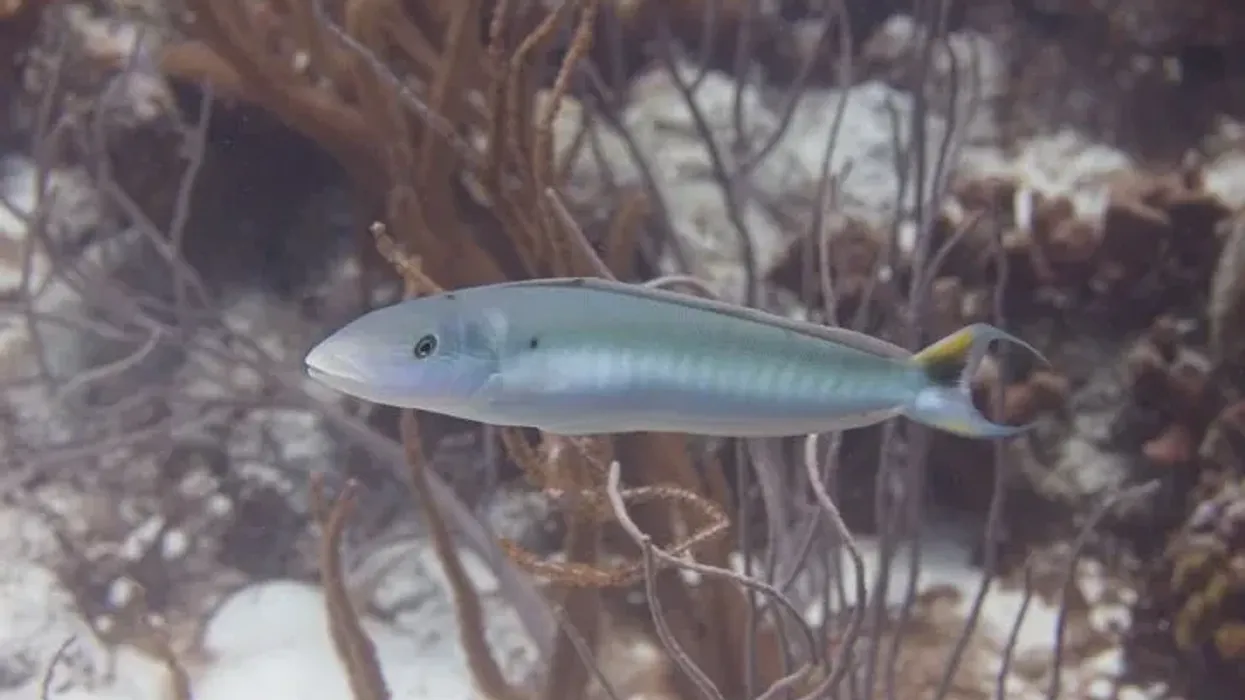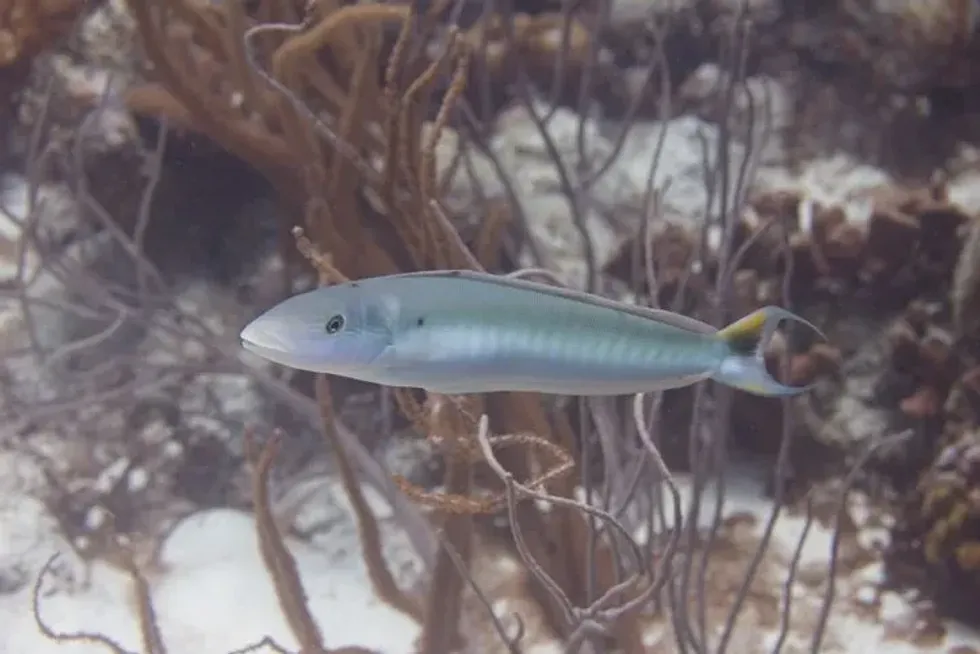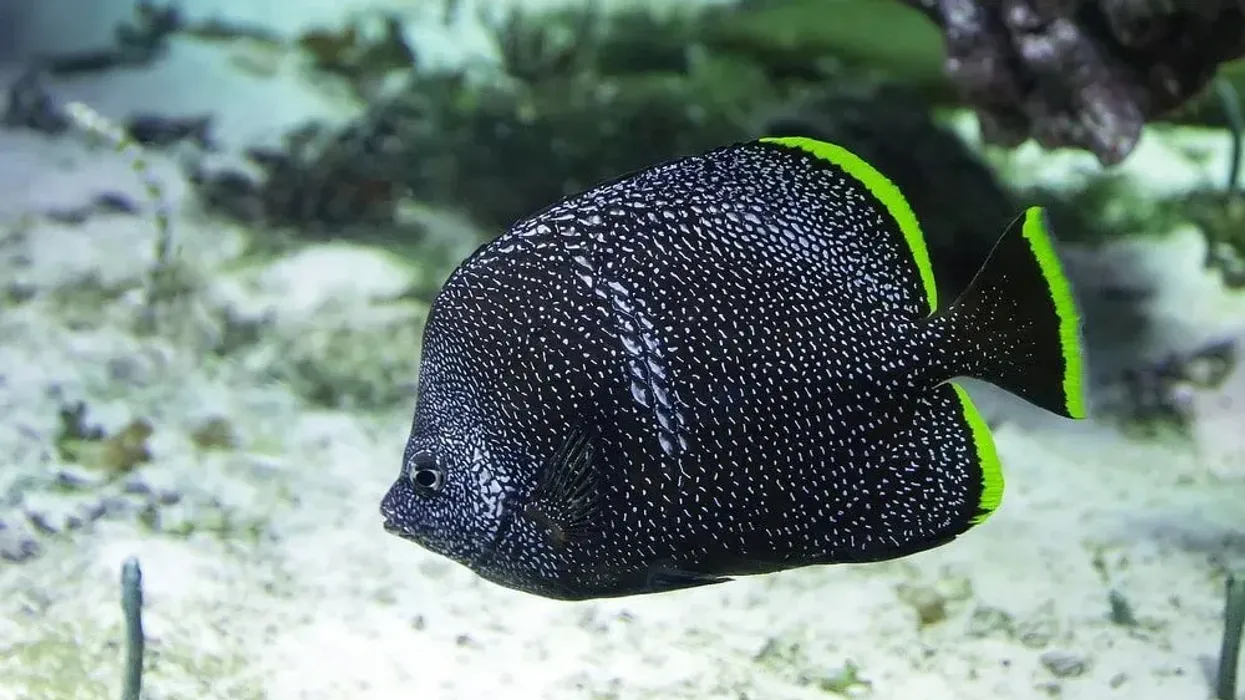Tilefish (Lopholatilus chamaeleonticeps), or commonly known as blanquillo, belonging to the family malacanthidae has 40 different species which are located all over the world. The largest tilefish is the great northern tilefish, or Lopholatillus chameleonticeps, which lives in the waters of the Atlantic Ocean and the Gulf of Mexico.
They are small-sized marine fishes with habitats near coral reefs or the sandy regions in tropical or temperate waters.
There are various tilefish species that have been categorized based on their appearance such as blackline tilefish, gray tilefish, rainbow tilefish, blueline tilefish, and blue head tilefish. These fishes have yellow and gold spots on their body and are ocean blue under the eyes.
Some species of the tilefish live in shallow waters while others live in deep-sea waters. Tilefish are opportunistic omnivores and mostly feed on crustaceans like crabs and shrimps.
Other small fishes like mollusks, sea urchins and squids are also a part of their diet. Some tilefish have vibrant colors like pinkish blue-green, and yellow, while some have dull colors like grey and brown.
While tilefish is popular amongst seafood lovers, the tilefish mercury rating is the highest. The FDA has listed tilefish amongst the four fish species that are high in mercury.
After reading this article on tilefish facts, do check our other articles on tang fish and tetra.
Tilefish Interesting Facts
What type of animal is a tilefish?
The tilefish is a small marine fish. Golden tilefish species are omnivorous in nature and feed on both plants and animals.
There are more than 40 species of tilefish found in the wild, which differ in appearance and habitat. All species of tilefish eat clams, shrimps, crabs, squids, sea cucumbers, and anemones. This fish species lives in burrows created at the bottom of the sea floor.
What class of animal does a tilefish belong to?
Tilefish is a fish belonging to a family of small fishes. The different species of tilefish are golden tilefish, great northern tilefish, purple tilefish and blueline tilefish. Golden tilefish species have a very long lifespan and can live for approximately 50 years. This species can be found in the waters from Florida to Nova Scotia.
How many tilefish are there in the world?
The conservation status of golden tilefish species is listed as Not Extinct, which means that their population is stable across Florida to Nova Scotia. But the great northern tilefish, one of the largest species of tilefish, is listed as Endangered on the IUCN red list.
Their population is less than average and is continuously declining. Other species of tilefish are far from extinction and have a large population in shallow and deep waters.
Where does a tilefish live?
Golden tilefish can live in deep and shallow waters where the climatic condition is moderate or tropical. Great northern tilefishes dig burrows in the bottom of the ocean and can go into a state of hibernation. Golden tilefish are found on muddy slopes, open water bodies and sandy regions which allow them to burrow near the outer continental shelf.
What is a tilefish's habitat?
The habitat of a tilefish changes according to its species. Great northern tilefishes are usually found in deep waters, while others can be found in shallow waters of the outer continental shelf.
Golden tilefish cannot survive in chilly waters and die when the water temperature decreases. Mass extinction of the great northern tilefish was observed when the climatic conditions changed, and the water became chilled.
Who do tilefish live with?
Most tilefish are solitary and dig their own burrows for hiding. Others are found in small groups, or pods. Tilefishes congregate during the mating period, and some have monogamous pairs. The purple tilefish is a fast swimmer and remains hidden during daylight.
How long does a tilefish live?
The average lifespan of a golden tilefish is 50 years, but the females can live for 46 years. These fish are long-lived, slow-developing perciform fishes belonging to the class of ray-finned fishes. They live in tropical and temperate conditions and cannot survive in extreme weather conditions.
Golden tilefish burrow holes in the sand and hide there for survival. The great northern tilefish also hibernates in the water. Change in weather, habitat degradation and overfishing are the main reasons that their population is declining.
How do they reproduce?
The breeding season in tilefish occurs between April to June when the climate is suitable for reproduction. The average female lays between two and eight million eggs during the spawning period.
The rare pastel tilefish build rubble mounds, which are used as a refuge by other species. The pastel tilefish builds a school above this mound where they breed.
The larvae are aquatic and drift as soon as they reach the juvenile stage. The larvae are not guarded or protected by the parents and are left to drift in the open stream.
What is their conservation status?
The conservation status of the tilefish ranges from Not Extinct to Endangered as per the species. The largest species of tilefish, the great northern tilefish, is listed as an Endangered species by the IUCN red list.
The pastel tilefish is also a rare species of the malacanthidae. The reason behind their dwindling population is rampant overfishing and habitat loss. This species is covered under the Individual Fishing Quota program and Snapper Grouper Fishery Management Plan in an attempt to keep the overfishing at bay.
Tilefish Fun Facts
What do tilefish look like?
Tilefish have a range of different colorations ranging from grey, yellow or gold to purple, pink, and blue green. Their attractive colors and elongated bodies make them look like beautiful sea creatures.
This fish has irregular yellow and gold spots on the body along with ocean blue under the eyes. All tilefish larvae have long spines. The dorsal and fins of tilefish are long.
Some species of tilefish develop a cutaneous ridge on top of the head while others grow a spine on the gill covers, which can be sharp or blunt. There is a large crest present on the head of the golden tilefish that distinguishes this ocean floor bottom dwelling species from others.
How cute are they?
Tilefish are not cute in appearance, but they can be very attractive pelagic creatures. Some species of tilefish have a vivid and vibrant coloration of purple, blue and green.
How do they communicate?
Tilefish burrow holes in the bottom of the ocean or build caves at the base of a coral reef, rock piles, and often in canyons and edges of muddy or steep slopes. This is where this fish can take shelter from predators.
Tilefish congregate during the mating season. Some species form schools, while others like the great northern tilefish do not form schools but instead build their burrows in close proximity to each other.
How big is a tilefish?
The body length of a tilefish can range from 4-50 in (10-127 cm) depending on the species, as there are more than 40 different species of tilefish found in nature.
How fast can a tilefish swim?
Tilefish can swim very fast as they often need to swim quickly in order to escape from predators and hide in their burrows. Tilefish are often hunted down by anglers and move into their refuge to avoid getting killed.
The average speed at which a tilefish swims is currently unknown, but most fishes can swim at a speed of 70 mph (112 kmph).
How much does a tilefish weigh?
The average weight of a tilefish is 10-35 lb (4.5-15 kg) but they can get as big as 50 lb (22 kg). The largest tilefish is the great northern tilefish which weighs 40-66 lb (18-29 kg).
The smallest tilefish, found in shallow waters, is the yellow tilefish, and they can weigh approximately 0.11 lb (0.04 kg). The great northern tilefish is also known as the golden tile or golden tilefish.
What are the male and female names of the species?
There are no particular names for the male and female species of tilefish.
What would you call a baby tilefish?
Tilefish babies have no specific name and are simply referred to as baby tilefishes or juvenile fishes. The parent tilefish do not guard the juveniles, and they are left alone to drift in the water body.
What do they eat?
Tilefish can survive on both animal and plant material. The sand tilefish eats crustaceans like shrimp, crabs and other small fish.
Other species eat small fishes, mollusks, squids, snails, worms, sea cucumbers and sea urchins. Crabs and shrimps are the staple diet of a tilefish. Large species of tilefish like the golden tile can consume larger fishes and other marine creatures.
Are they dangerous?
Tilefish have a heavy amount of mercury deposited in the body, which when consumed by a human being, can be very dangerous. Mercury is a toxic metal and causes further health conditions and poisoning in the body.
Only a few species of tilefish are safe to eat. Atlantic tilefish, after research, was declared safe to consume only at moderate levels.
Would they make a good pet?
Tilefish are solitary in nature, although some live in small groups. Tilefish hide in their burrows or keeps digging for their survival.
Small crevices, ridges, holes in the bottom of the ocean are dug by the tilefish as a pastime. This fish species also hide in these holes when they have nothing to do. Even if a tilefish survives in an aquarium or tank, they may not live for their entire lifespan.
Did you know...
Tilefish has a history of being a commercial fish. The most vibrant tilefish is known as the colorful tilefish, also called the clown of the sea. The 40 different species of tilefish belong to two subfamilies, the latillinae and the malacanthidae. The predators for this fish species are spiny dogfish, conger eels, and sharks.
What does tilefish taste like?
Tilefish has a fresh flavor which is similar in taste to a crab or lobster. The fillets of a tilefish are pink in color when raw, which turns white after they are cooked.
The texture of the cooked fillets is flaky. The fresh flavor of tilefish meat is the same as that of a crab or lobster because tilefish consume crustaceans on a large scale.
Various tilefish recipes are available for you to try cooking tilefish such as grilled tilefish, pan seared tilefish and baked tilefish. Before you try any tilefish recipe, do remember that this species has very high mercury levels when compared to other seafood options.
How to cook tilefish
Tilefish fillets can be pan-seared, baked, grilled, or deep-fried like most other seafood to enhance their flavor. The quality of the tilefish should be checked as tilefish contains mercury.
This fish must be cleaned with water, and their scales must be removed. Frozen meat of a tilefish can be readily available in the market, which is safe to consume and needs to be fried or grilled after marinating. Tilefish price per pound is around 20 USD.
Here at Kidadl, we have carefully created lots of interesting family-friendly animal facts for everyone to discover! Learn more about some other fish including herring, or fluke fish.
You can even occupy yourself at home by drawing one of our Tilefish coloring pages.










